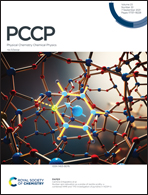Tri-atomic Pt clusters induce effective pathways in a Cocore–Pdshell nanocatalyst surface for a high-performance oxygen reduction reaction†
Abstract
The crux of the hot topic concerning the widespread replacement of fuel cells (FCs) with traditional petrochemical energy is to balance improving the oxygen reduction reaction (ORR) and reducing the cost. The present study employs density functional theory (DFT) to investigate the effect of Pt ensemble size regulation from a single atom to full coverage on the physio-chemical properties, oxygen adsorption energies and overall ORR efficiency of bimetallic nanocatalysts (NCs) with a Cocore–Pdshell structure. Our results reveal that the electronegativity difference and lattice strain between neighboring heteroatoms are enhanced to trigger a synergetic effect in local domains, with the Pt cluster size reduced from nanometers to subnanometers. They induce a directed and tunable charge relocation mechanism from deep Co to topmost Pt to optimize the adsorption energies of O2/O* and achieve excellent ORR kinetics performance with minimum Pt usage but maximum Pt atom utilization (i.e., Pt1 to Pt3) compared with benchmark Pt(111). Such a dependency between the cluster size and corresponding ORR performance for the established Co@Pd–Ptn system can be applied to accurately guide the experimental synthesis of ordered heterogeneous catalysts (e.g., other core@shell-clusters structures) toward low Pt, high efficiency and green economy.



 Please wait while we load your content...
Please wait while we load your content...